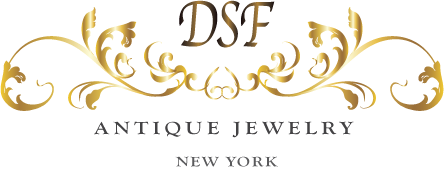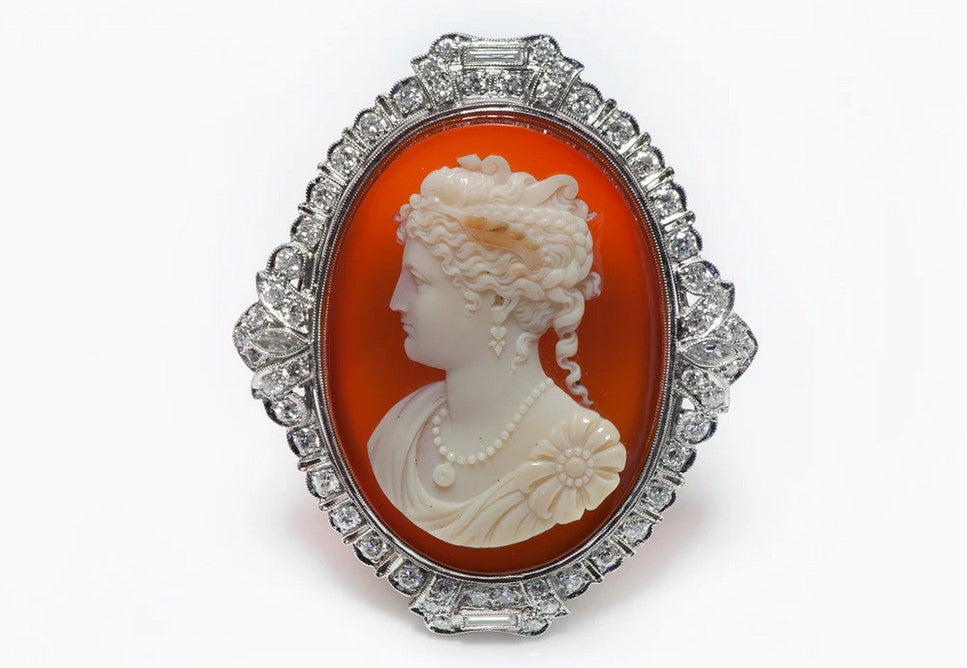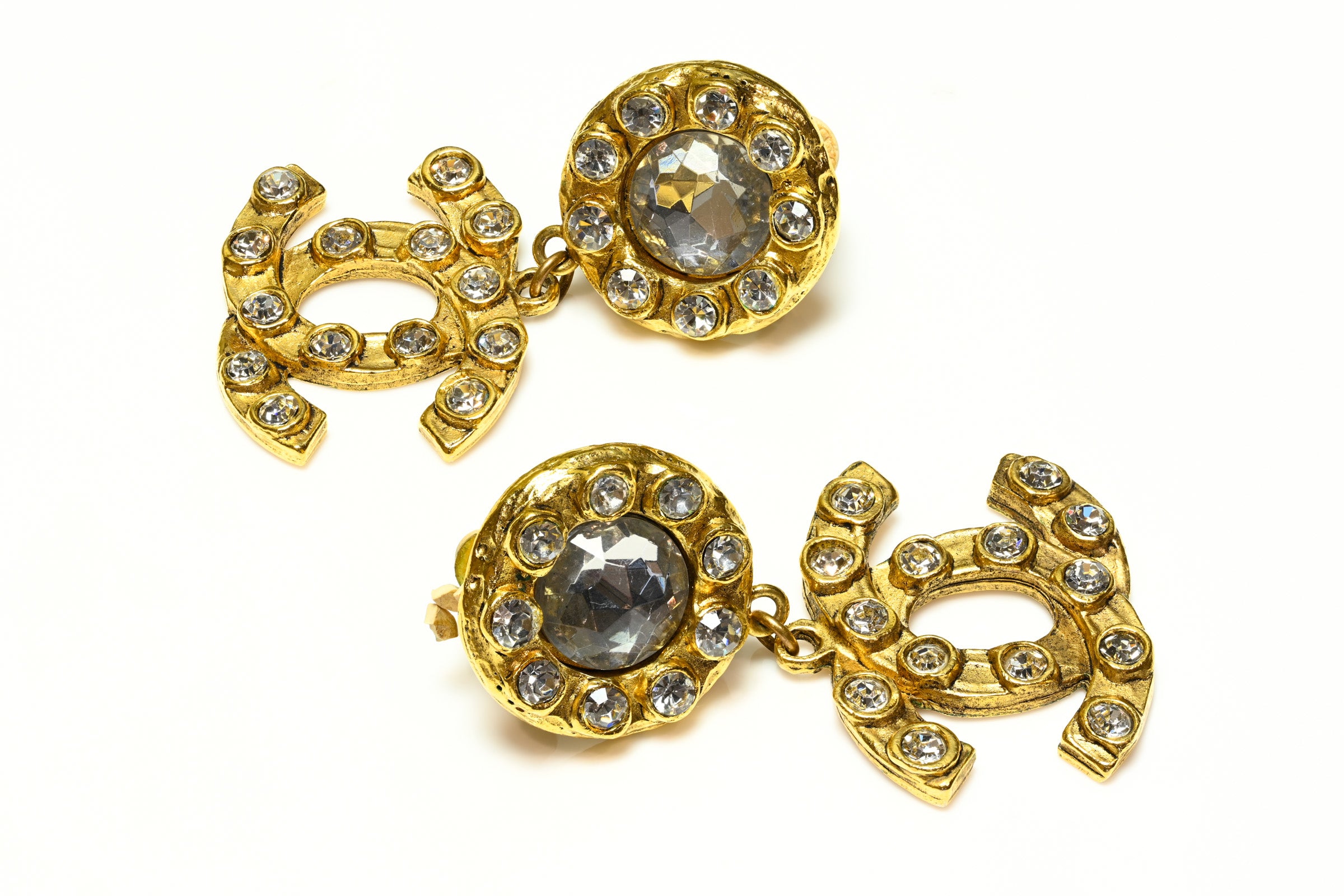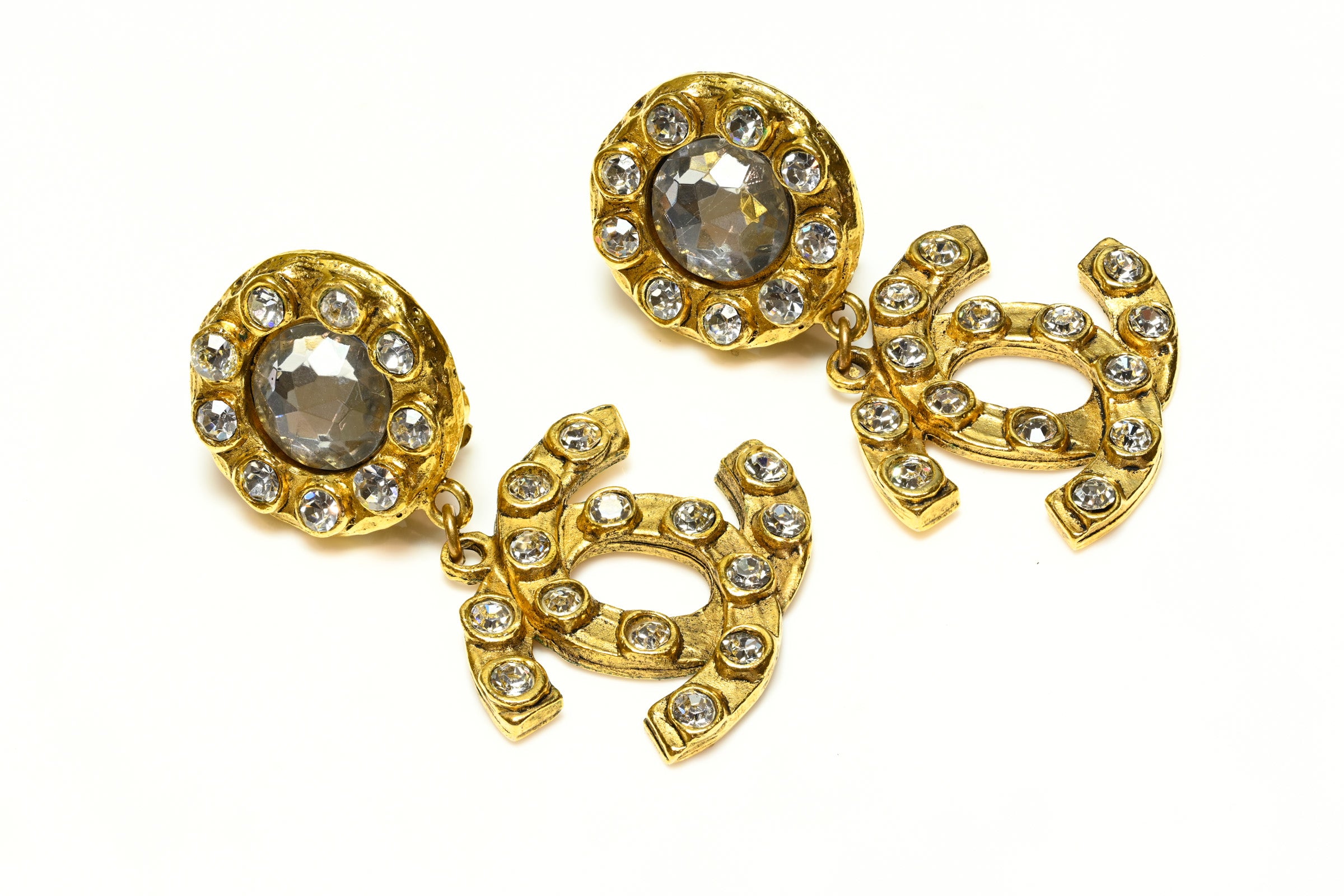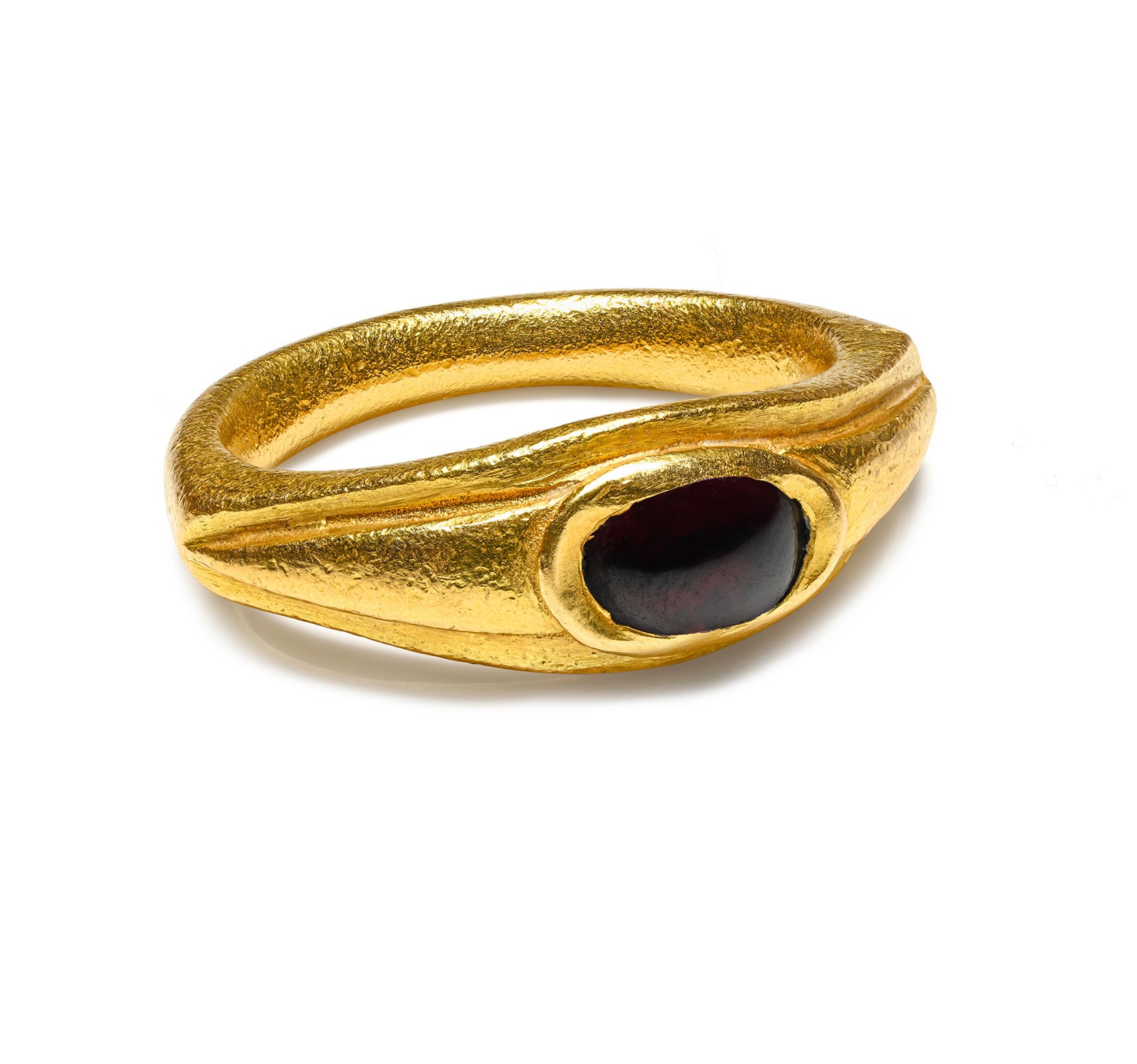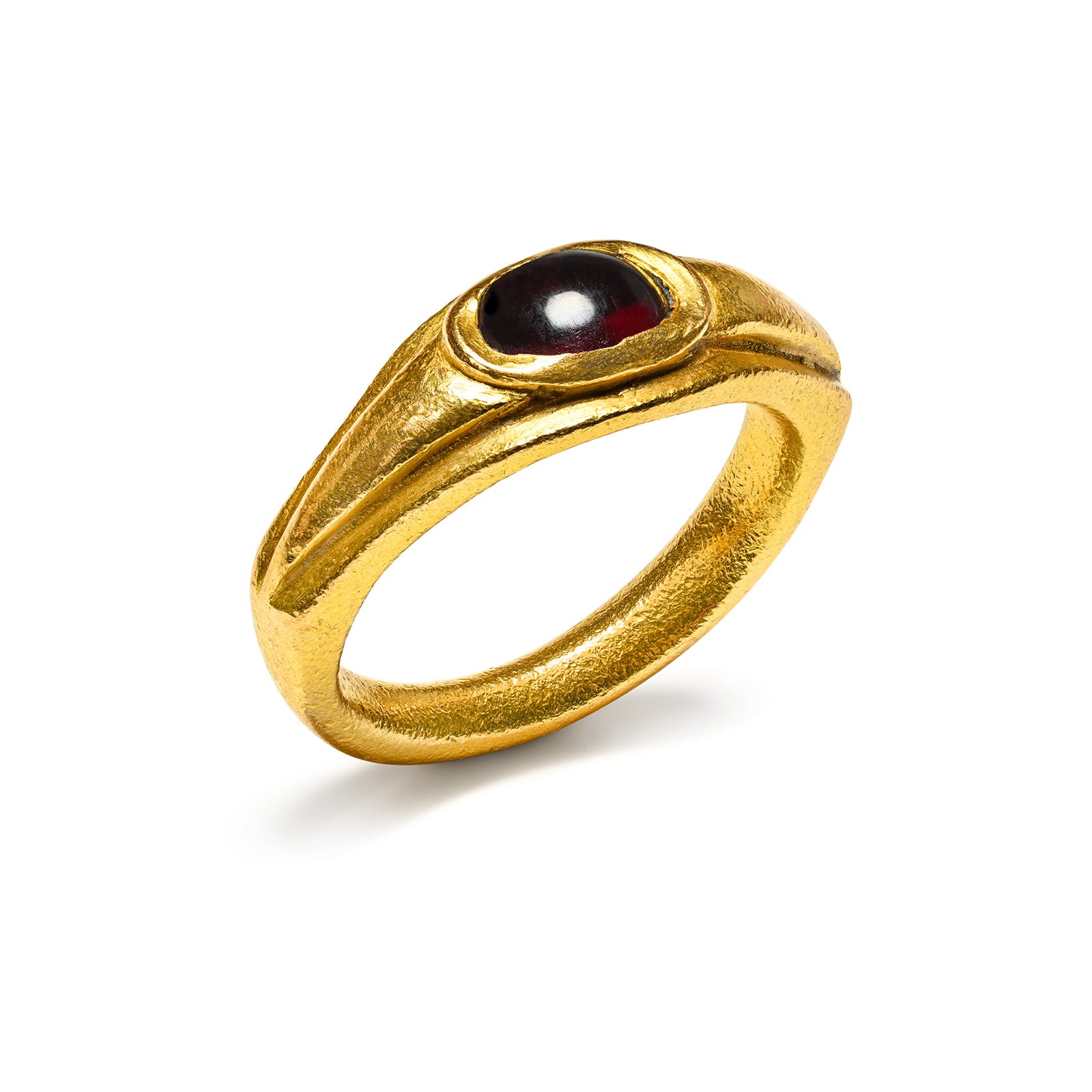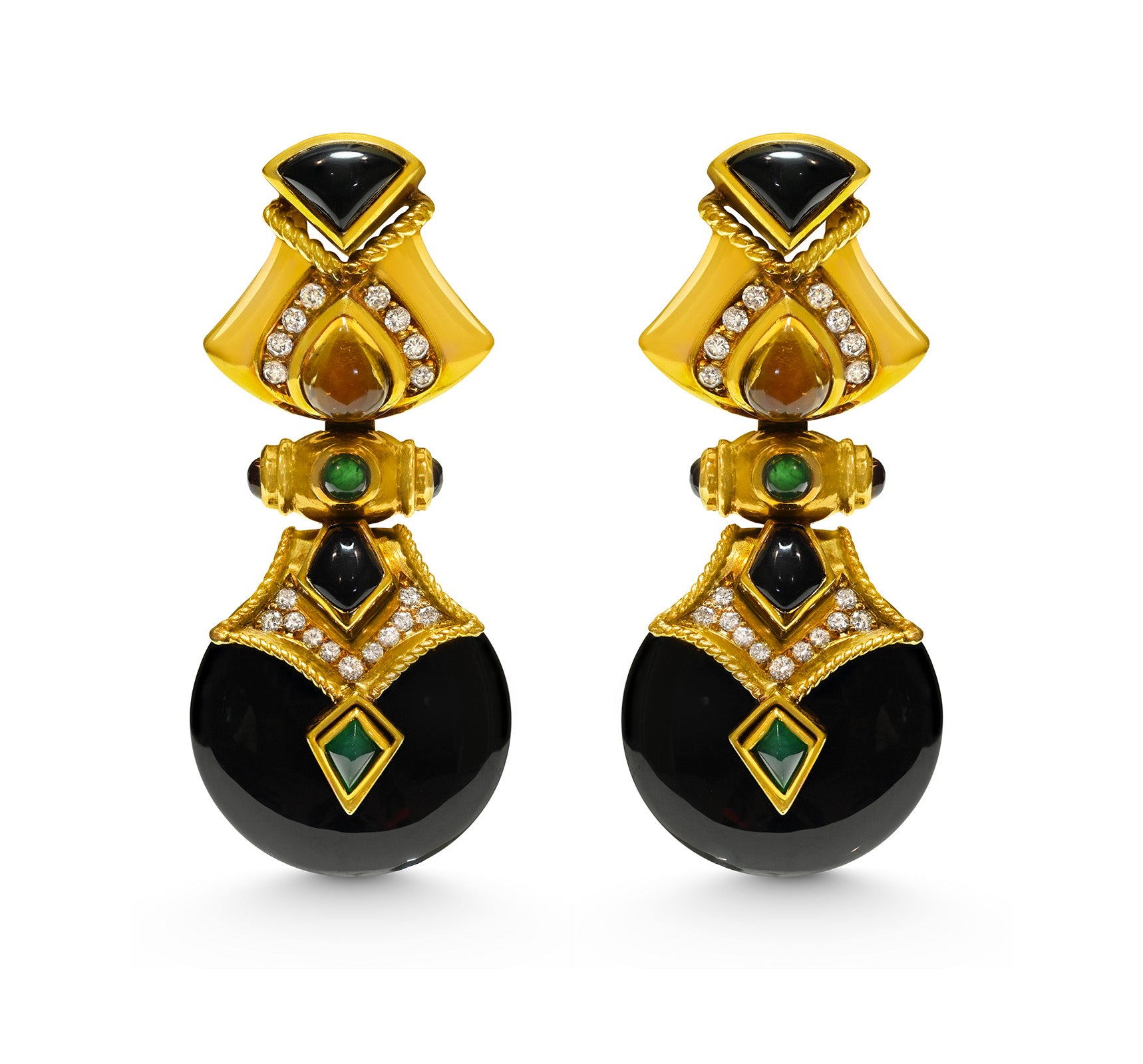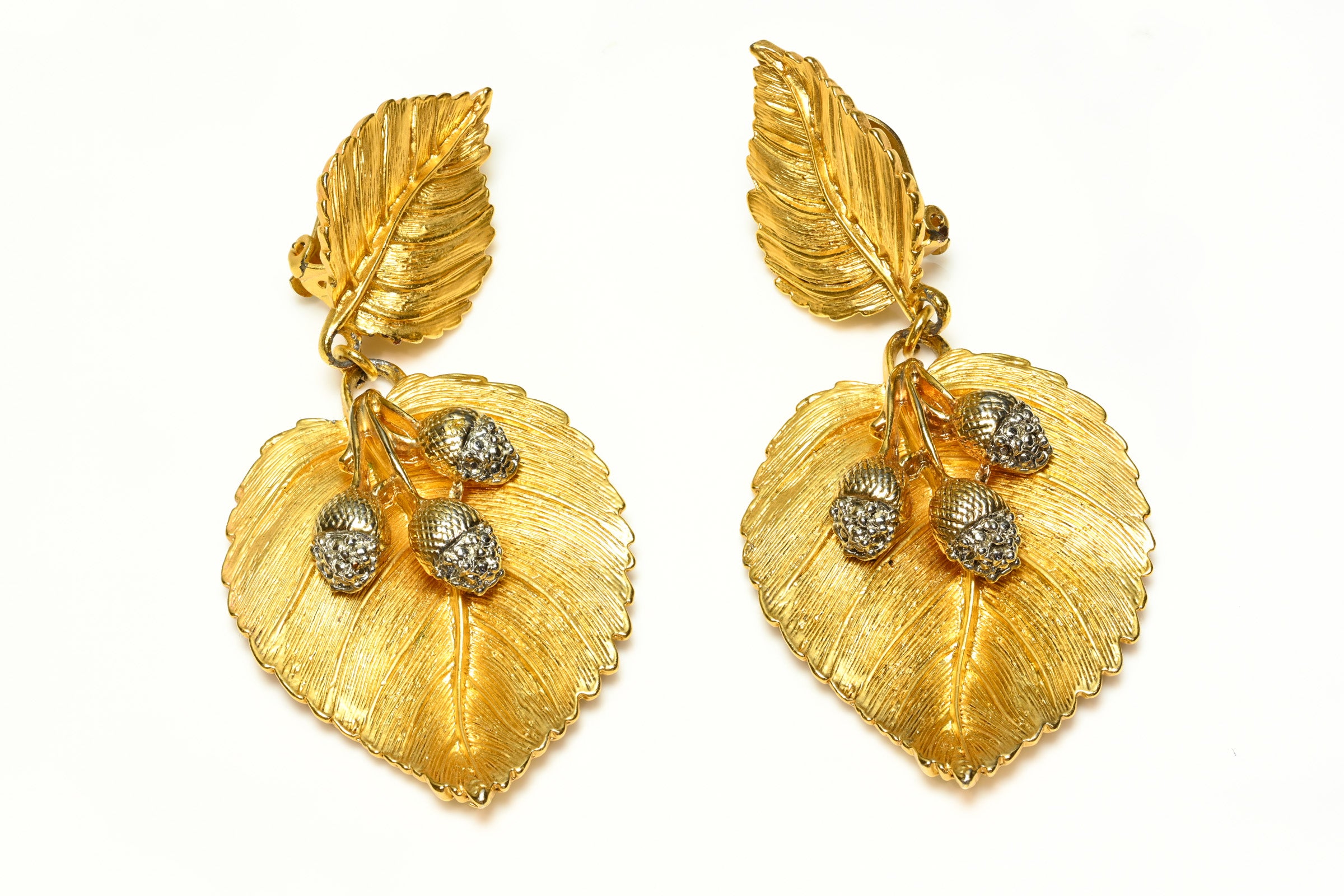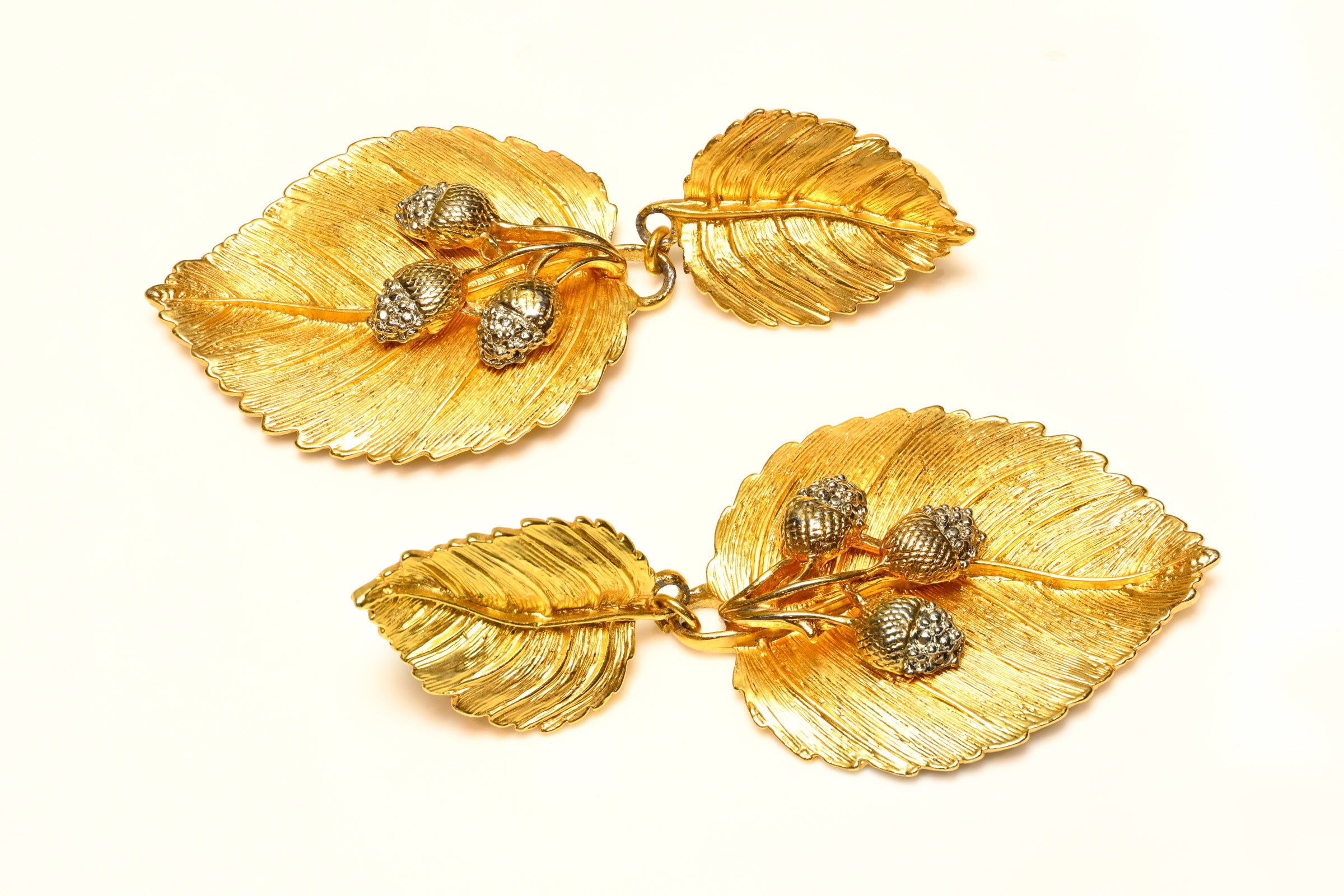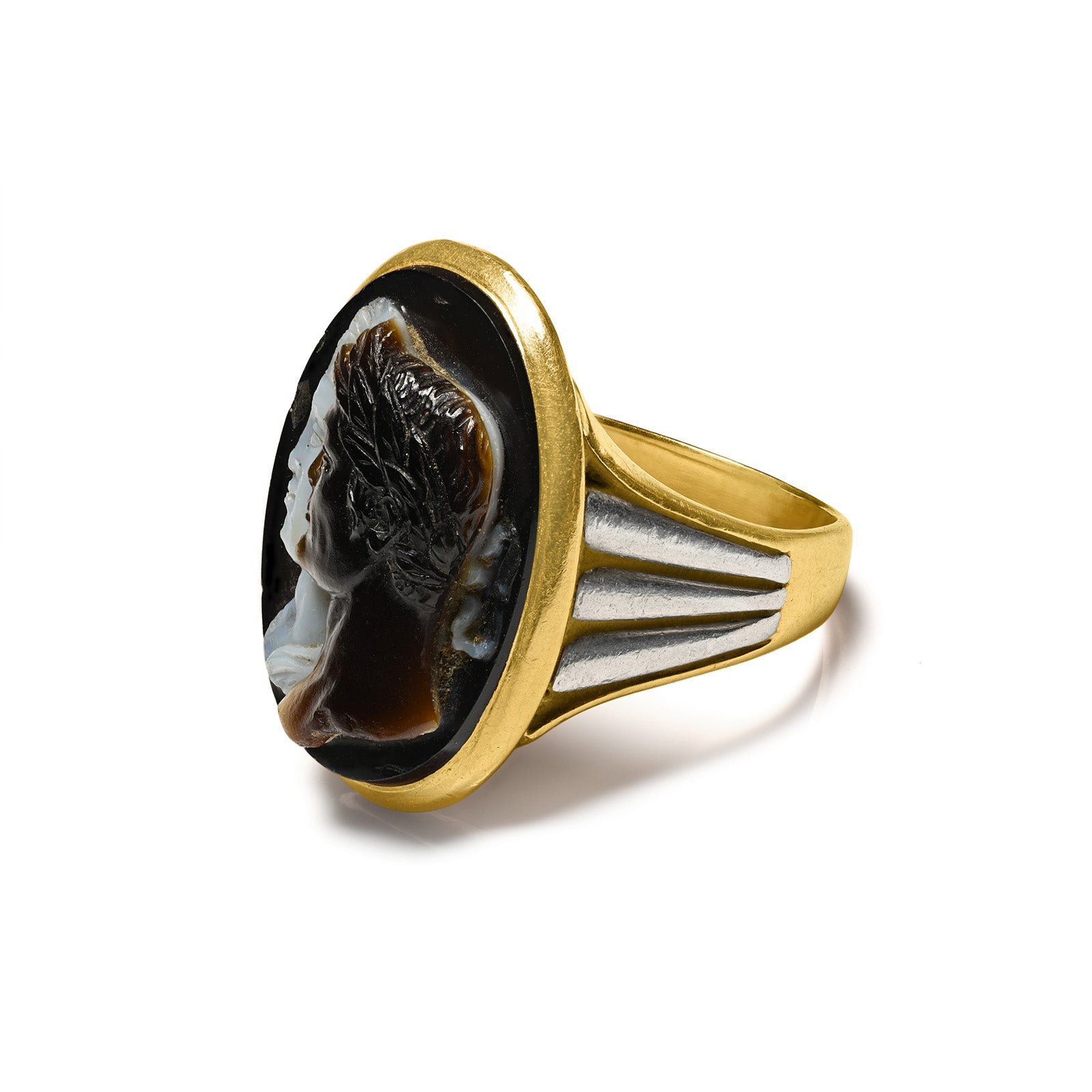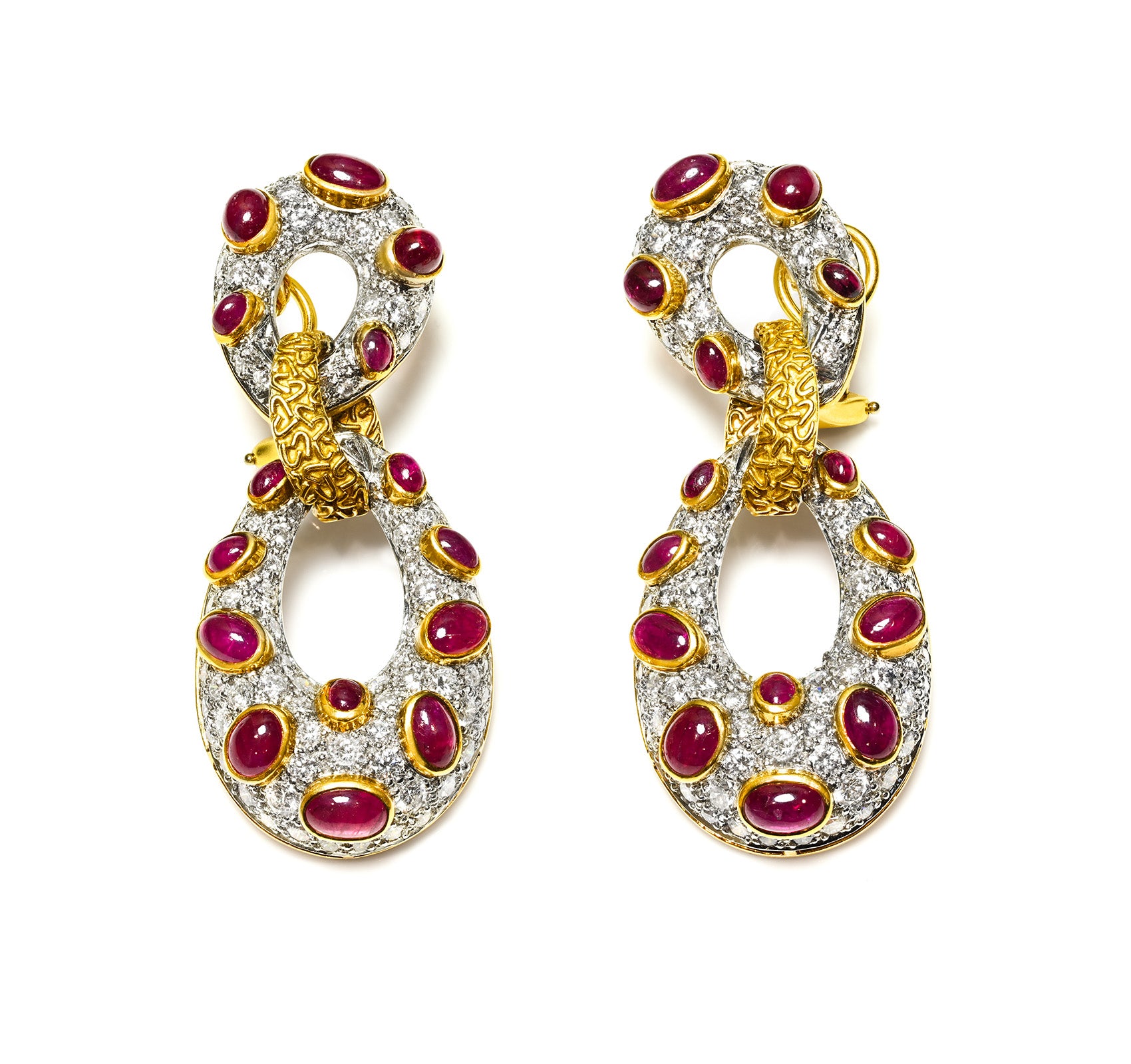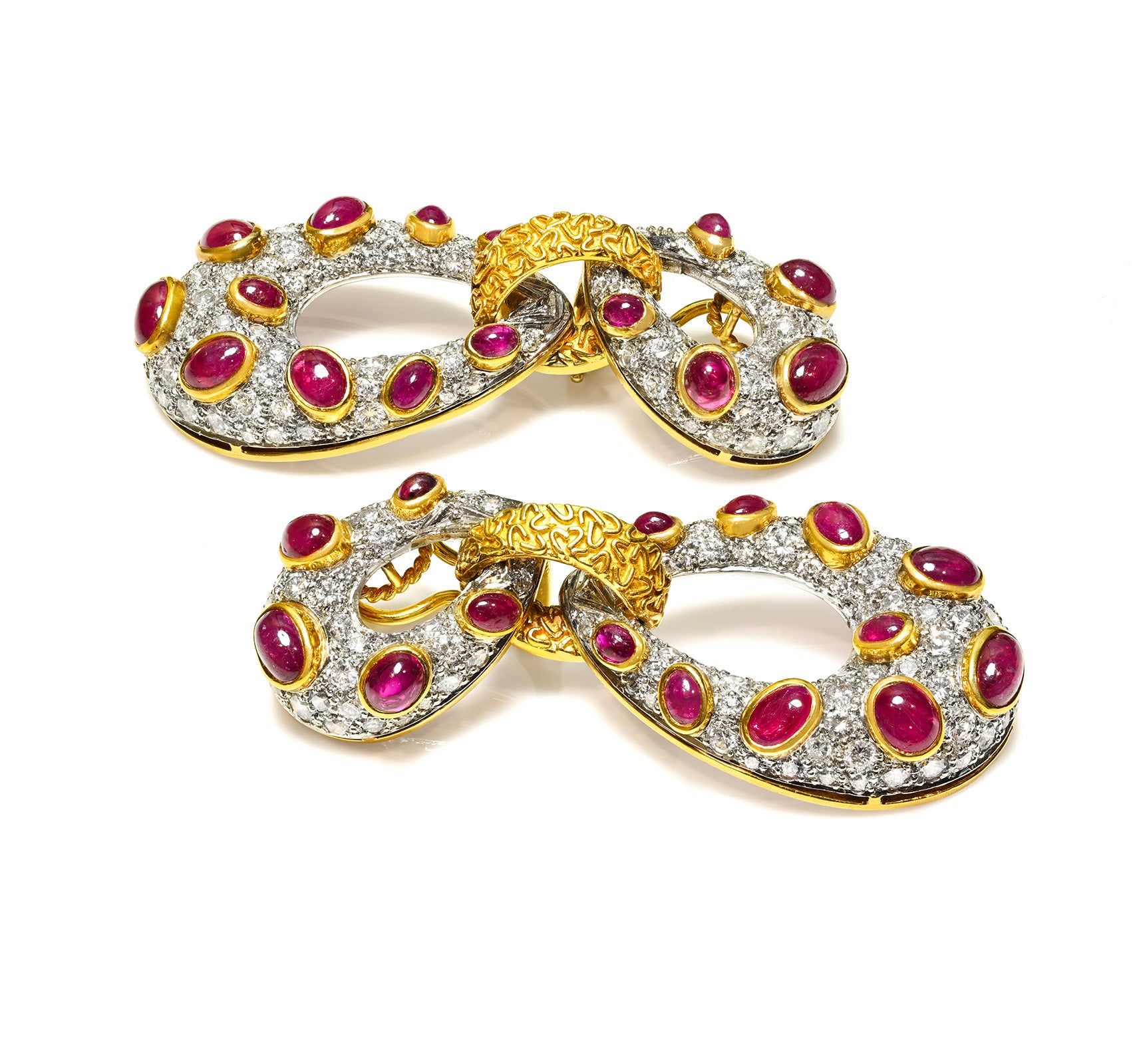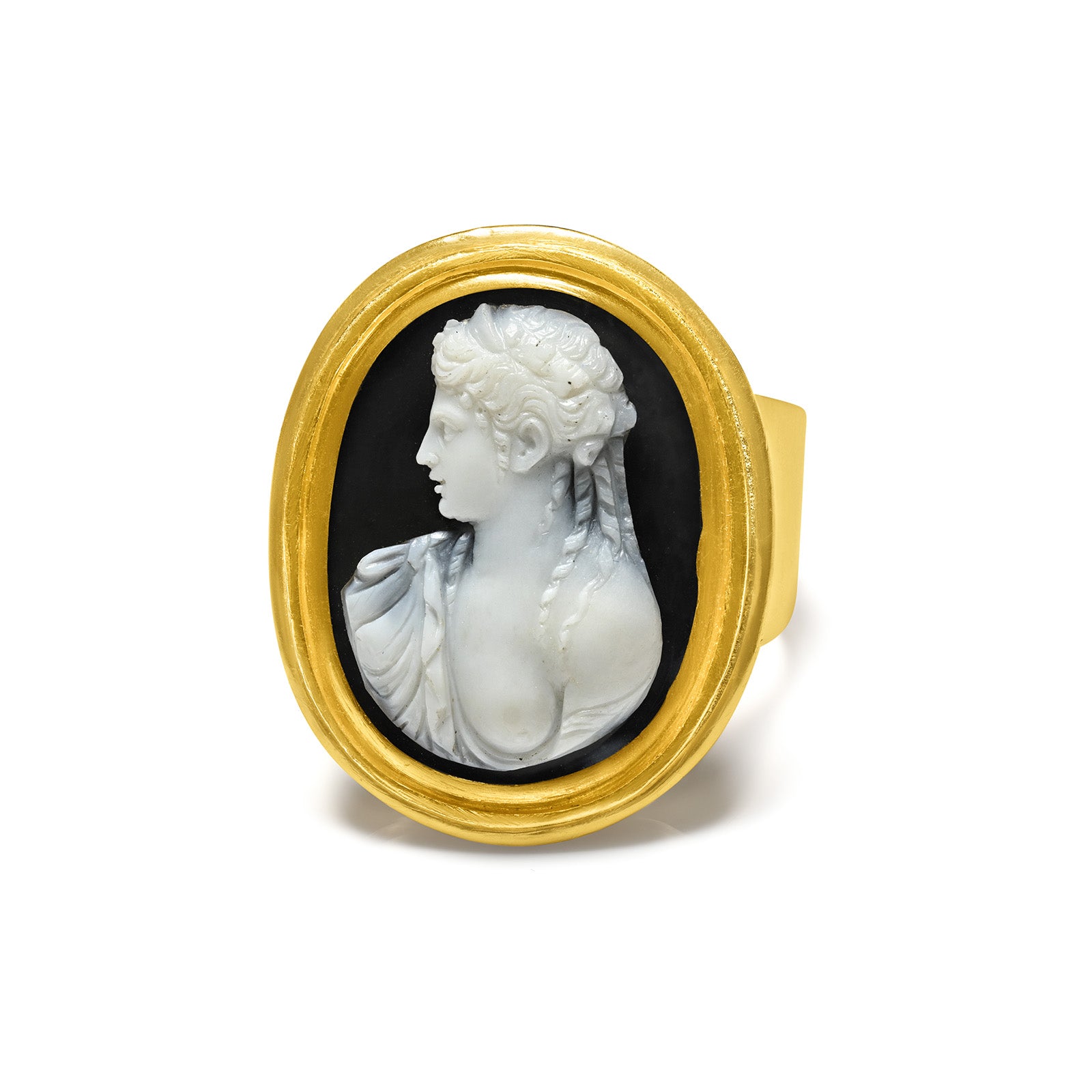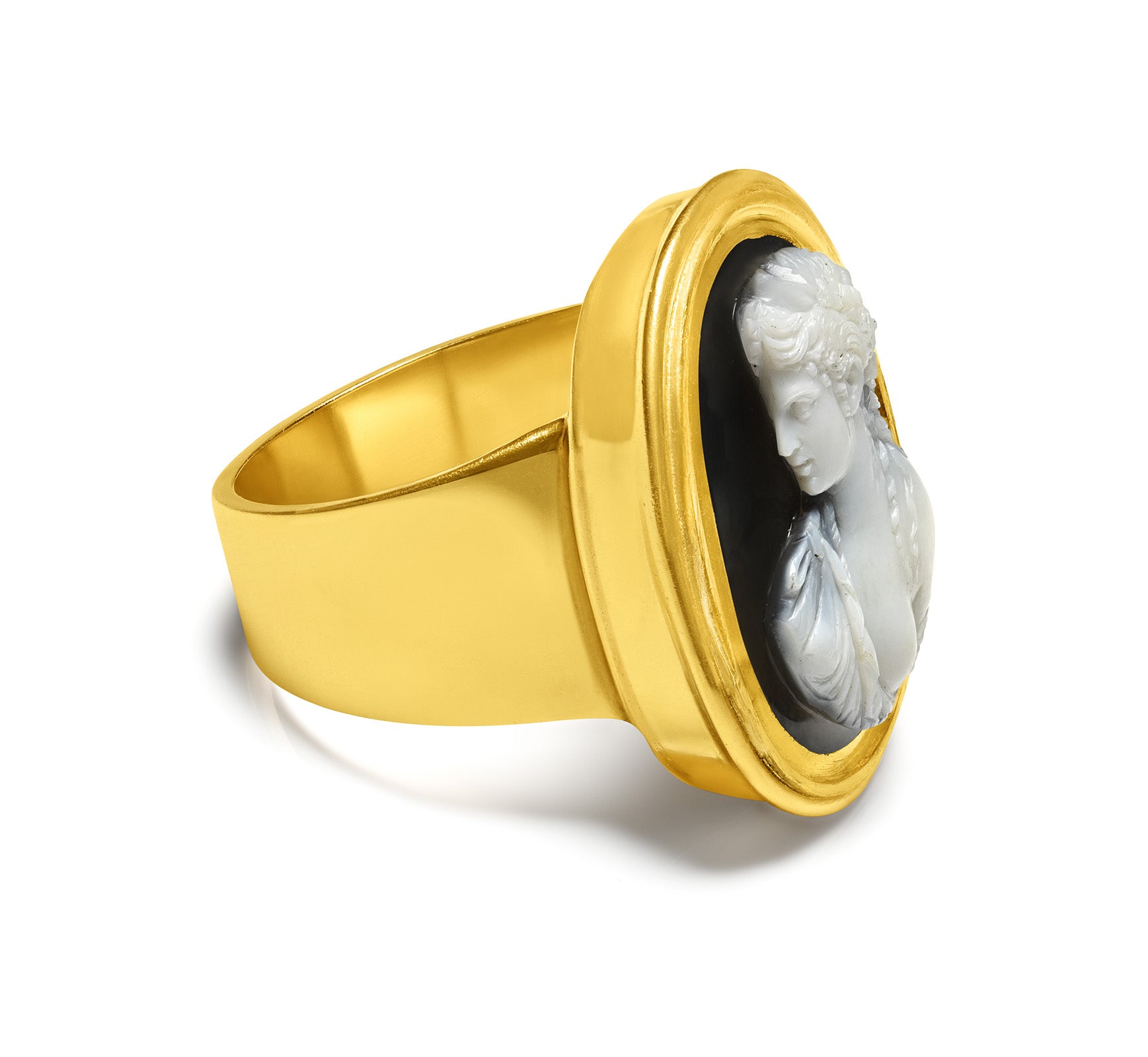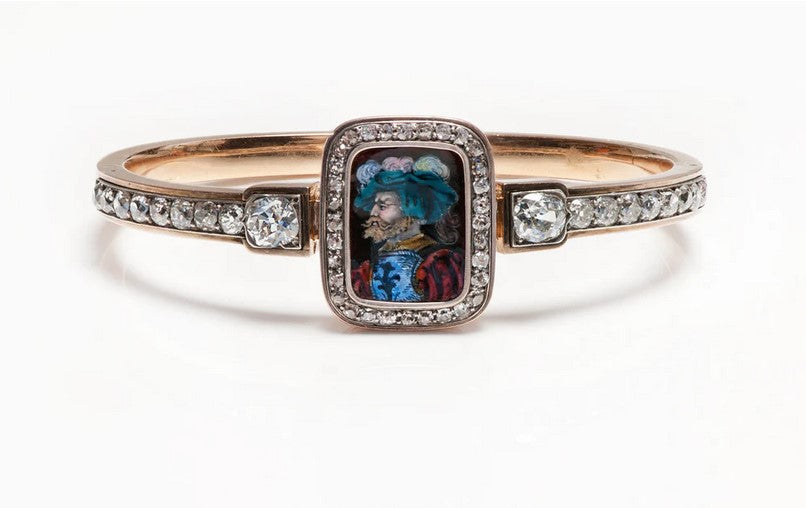
Victorian Jewelry: The Legacy of a Trendsetting Queen
The Victorian era was a time of profound transformation, characterized by innovations in fashion, industry, and society.
Jewelry design during this period reflected these sweeping changes, incorporating newly developed machinery and techniques that set it apart. Jewelry was predominantly a feminine domain in Victorian society.
Worn primarily by women, jewels became an essential part of their identity, while it was considered unconventional for men to wear them.

Victorian Carved 18K Gold Wide Bangle Bracelet - DSF Antique Jewelry
The Victorian Era – A Glimpse into History
Queen Victoria's reign, which spanned from 1837 to 1901, defined the Victorian era, shaping its art, culture, and even its jewelry. The term "Victorian" has since become synonymous with the artistic and cultural achievements of this transformative period.
Jewelry played a significant role in Queen Victoria's life, marking milestones such as the birth of each of her nine children, family weddings, anniversaries, and royal events.

Painting of Queen Victoria by Franz Xaver Winterhalter - Wikimedia Commons
Skilled jewelers, many of whom fled to Britain amidst continental turmoil, were tasked with crafting stunning pieces for the Crown, contributing to the era's legacy.
The emergence of photography during Victoria's reign revolutionized mass media, offering new ways to immortalize jewelry trends. By the century's end, Victorian jewelry had become the dominant style, although other movements emerged alongside it.

Antique Rare Gold Amazing Cameo Men’s Ring with Four Faces - DSF Antique Jewelry
The Social and Cultural Landscape
Victorian society placed a premium on morality, which was both a catalyst for social reform and a limitation on personal freedoms for some groups. Prosperity grew during this time, yet severe challenges like malnutrition, disease, and inadequate housing persisted.
Early education and literacy flourished, marking significant progress, but the disparity between social classes remained stark.
From horse-drawn carriages to the dawn of electricity, the Victorian era bridged traditional and modern worlds. This dynamic period also cemented Queen Victoria's influence over fashion and jewelry design, leaving an enduring legacy that continues to inspire. 
Antique Victorian Cherubs Angels 18K Yellow Gold Brooch - DSF Antique Jewelry
Victorian Jewelry – A Reflection of an Era
Queen Victoria's influence on jewelry design shaped the evolution of Victorian styles, dividing this era into three distinct periods: the Romantic Period (1837–1861), the Grand Period (1861–1885), and the Aesthetic Period (1885–1901).
Each period introduced distinctive themes, materials, and techniques, leaving a lasting legacy on jewelry craftsmanship.
The Romantic Period
The Romantic Period marked the beginning of Queen Victoria’s reign, a time when jewelry design flourished with inspiration from natural and historical themes. Gold became increasingly accessible, aiding in the production of intricate, handmade pieces.
Nature-Inspired Motifs
Designers often celebrated the natural world, adorning jewelry with bouquets of flowers, branches, leaves, grapes, and berries.
Floral symbolism was deeply intertwined with sentimentality, while serpentine designs gained prominence.
Snake jewelry, in particular, symbolized wisdom and eternity—a nod to ancient traditions.
Materials and Craftsmanship
Jewelry during this period incorporated an array of materials, including:
- Metals: High-karat gold (22k and 18k), tri-color gold, and silver. Post-1854, lower karat gold (9k, 12k, and 15k) became legal, making English jewelry more competitive globally.
- Gemstones: Diamonds, amber, amethyst, emerald, quartz, and onyx.
- Organic Elements: Seed pearls, ivory, coral, tortoiseshell, and agate.
Every piece was crafted by hand, reflecting a dedication to artistry and precision. Common jewelry types included bracelets, rings, brooches, and cameos—each intricately designed and steeped in symbolism.
The Romantic Period set the stage for Victorian jewelry’s timeless appeal, blending nature’s beauty with historical influences. With each piece telling a story, these jewels continue to captivate collectors and enthusiasts alike.
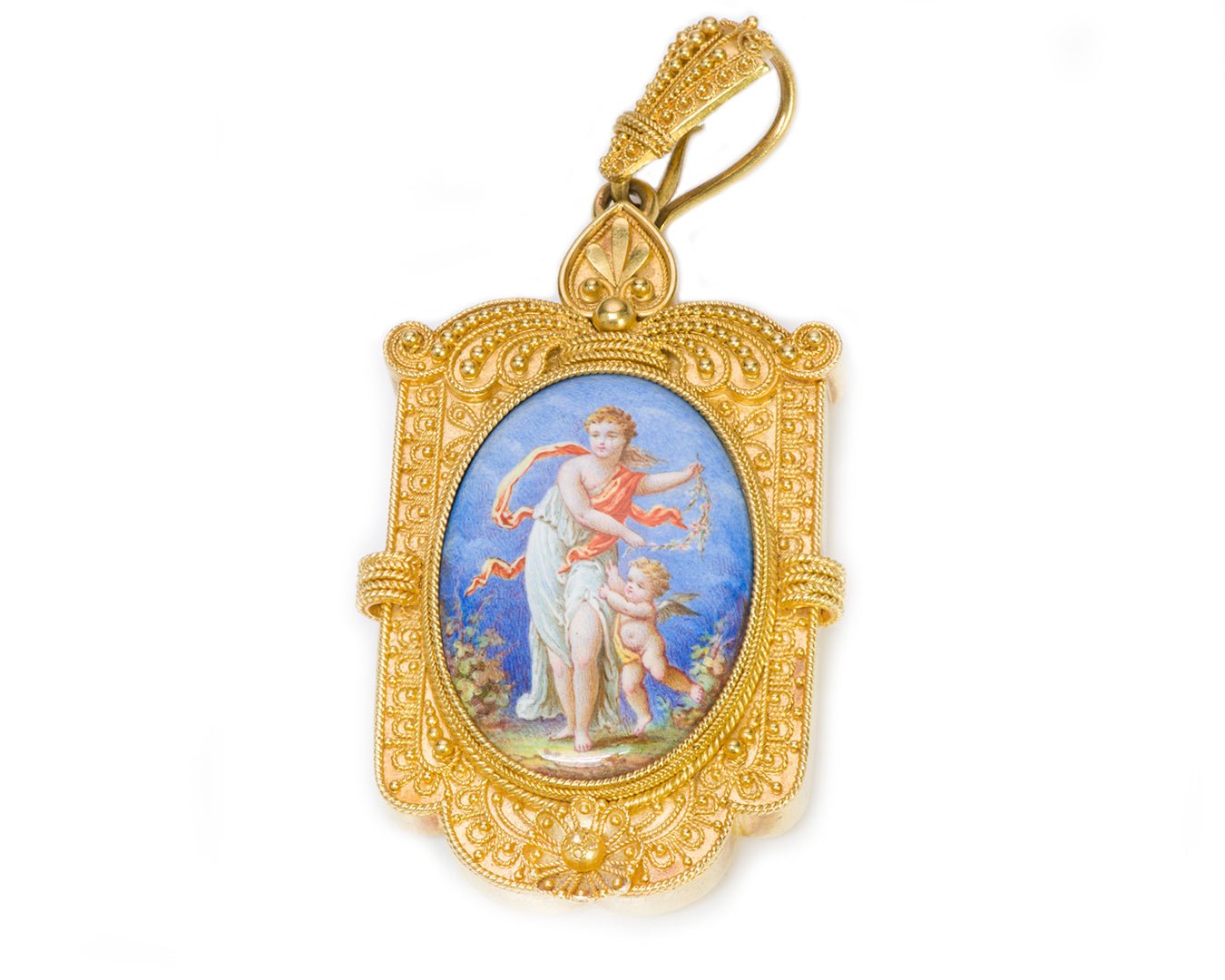
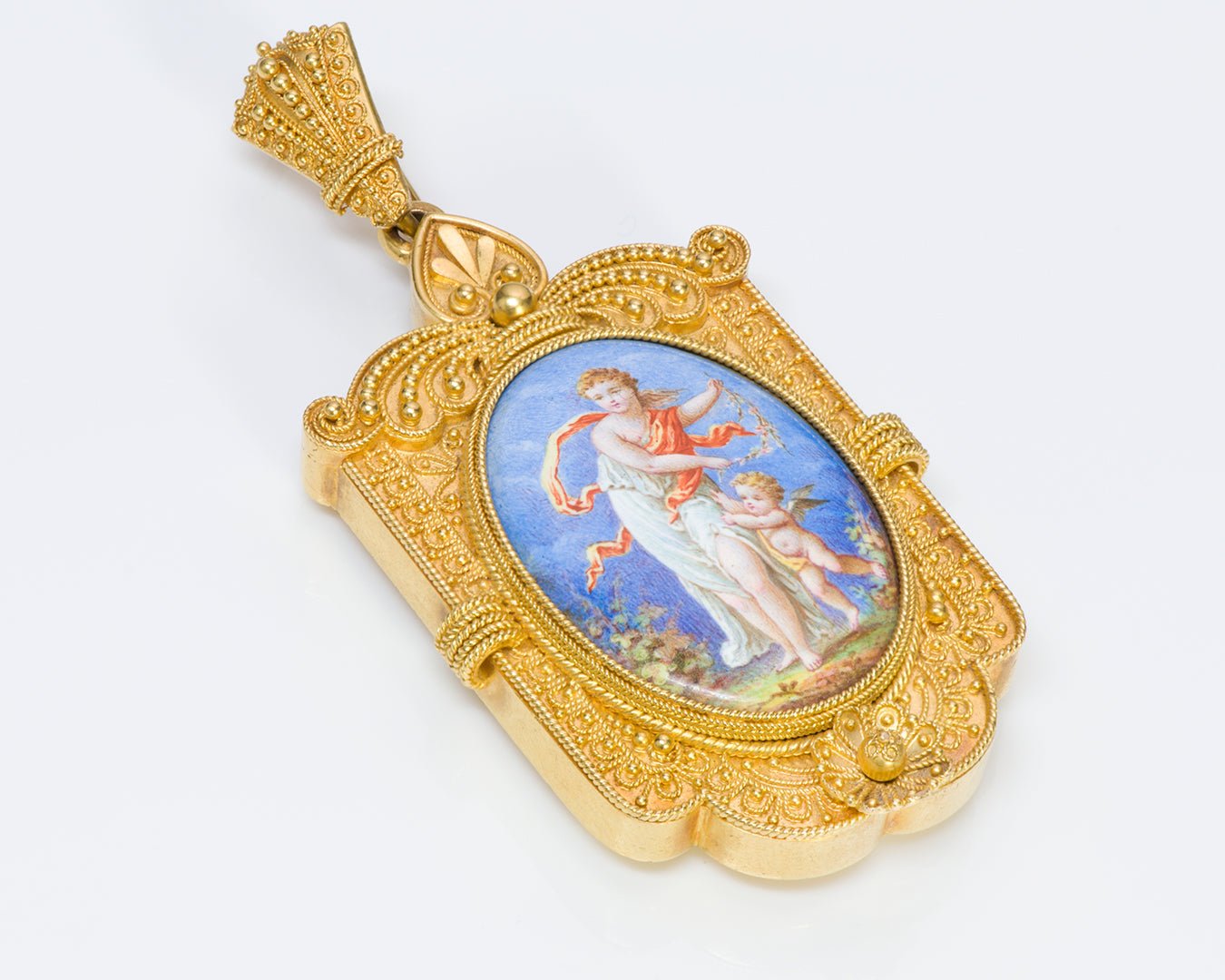
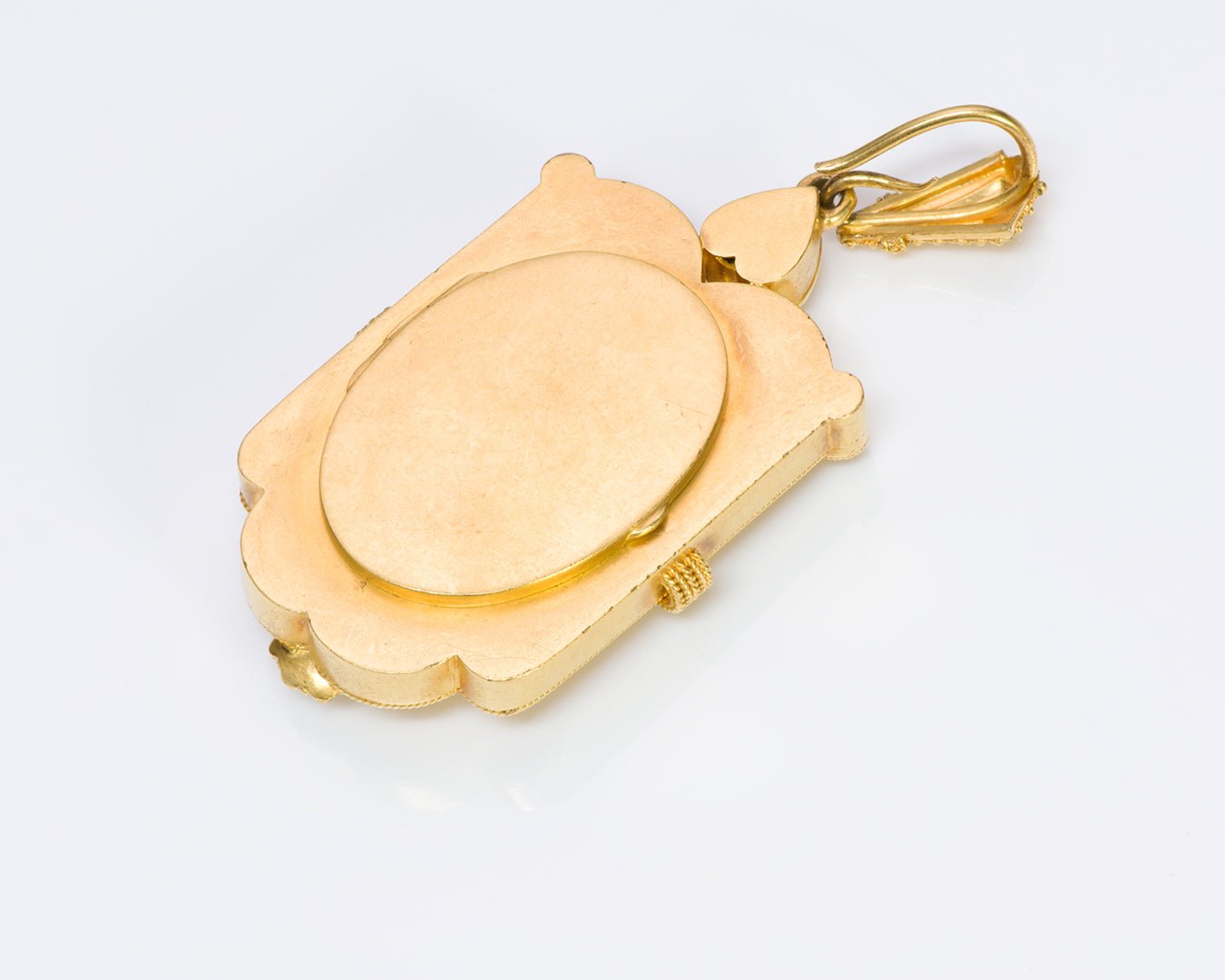
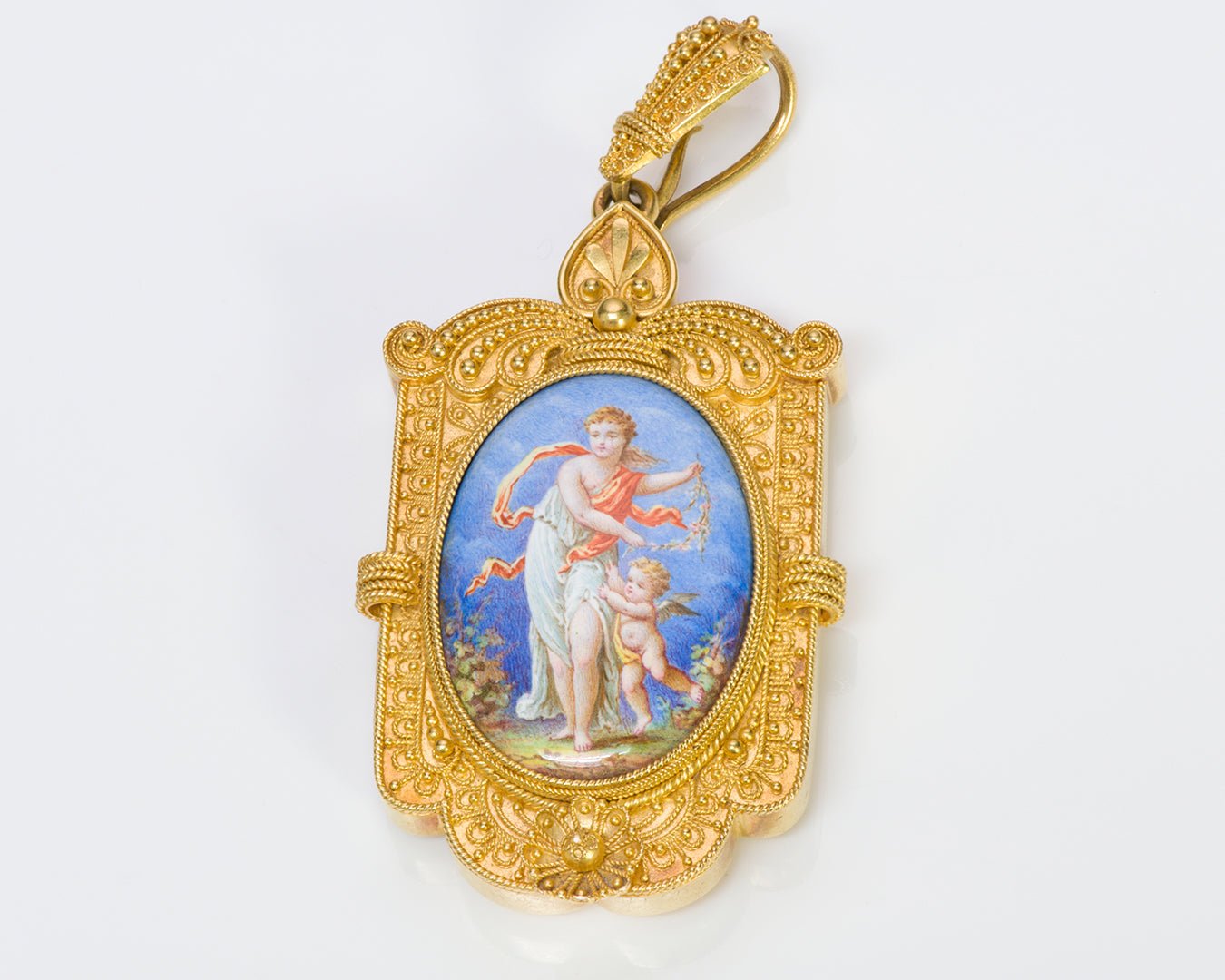
The Grand Period
The Grand Period, spanning 1861 to 1885, marked a shift from the delicate designs of the early Victorian era to bolder, more dramatic styles. This evolution reflected broader societal changes, particularly the changing roles and representation of women.
Materials and Themes
Jewelry from this period incorporated a diverse array of materials, including:
- Metals: Gold with a "soft" finish and silver.
- Stones and Organic Elements: Colorless gemstones, jet, ivory, and pearls.
- Innovative Craftsmanship: Gems were adapted to suit intricate metalwork designs, with calibré-cut stones and rose-cut garnets forming floral or star motifs around central carbuncles.
Design themes showcased nature's smaller creatures, such as flies, butterflies, dragonflies, and beetles, adding a whimsical yet refined touch to the jewelry.

Queen Victoria, Prince Albert, and the Royal Family (Source: F. Winterhalter via Wikimedia Commons)
Fashion and Cultural Influences
This era’s fashion underwent striking changes. Women embraced enormous crinolines and tighter corsets, accentuating décolletages and necklines. Hairstyles featured cascading curls at the nape, bringing earrings back into prominence.
A fascination with history, fueled by archeological discoveries, inspired a revival of Renaissance and medieval jewelry styles.
Designers like Carlo Giuliano adopted these influences, creating iconic neo-Renaissance pieces adorned with enamel, pearls, and gemstones. His lozenge-shaped pendants, suspended from multistrand seed pearl necklaces, were especially admired.


Royal Patronage and French Influence
The Second Empire in France, led by Napoleon III and Empress Eugénie, brought courtly elegance back into fashion. Eugénie, an enthusiast of 18th-century styles, influenced trends by redesigning the Crown Jewels in the Louis XVI style.
Her love of emeralds elevated their desirability to rival that of diamonds, and tiaras became essential accessories in aristocratic wardrobes.
Innovative Craftsmanship
Jewelry designs evolved to prioritize intricate metalwork, with gems adapting to these new structures. Calibré-cut stones and rose-cut garnets often framed central carbuncles in floral and star patterns, creating distinctive designs.
Popular pieces from this period included earrings, brooches, bracelets, ornate evening necklaces, and lockets designed for casual daywear.
This era celebrated a harmonious blend of history, nature, and bold innovation, leaving a lasting legacy in the world of jewelry.

The Aesthetic Period
The Aesthetic Period, spanning from 1885 to 1901, marked a transformative era in Victorian jewelry. This final stage in Victorian jewelry history reflected societal changes, including the growing independence of women and shifts in their fashion and jewelry preferences.
Shifts in Jewelry-Wearing Traditions
Women began to wear jewelry less frequently, reserving ornate pieces for special occasions. This shift aligned with the rise of women's political organizations and a broader embrace of intellectual and social independence.
Minimalism became a statement, with everyday adornments reduced to understated earrings and simple brooches, while bracelets nearly disappeared from the fashion scene.
Queen Victoria continued to influence trends, encouraging the use of mourning jewelry to commemorate loved ones.
Materials and Themes
Common materials during this period included:
- Gemstones: Emeralds, opals, and amethysts.
- Design Themes: Romantic motifs such as flowers, butterflies, and soft, natural hues made a resurgence, celebrating femininity and subtle elegance.
Gem Cutting Innovations
Distinctive cutting styles popular in the Aesthetic Period added to the appeal of gemstones:
- Rose Cut: A flat-bottomed, domed top resembling a blossoming rose.
- Old Mine Cut: A rounded square precursor to the modern brilliant cut.
- Cabochon: Featuring a flat base and smooth, rounded top for a sleek and polished look.
Jewelry as a Marker of Social Identity
In Victorian society, jewelry was a powerful symbol of social status, wealth, and respectability. It reinforced class distinctions, with gems signifying affluence and modernity.
However, the rise of rapid manufacturing allowed the burgeoning middle class to purchase imitations of these prestigious jewels, making fashion more accessible while still highlighting social hierarchies.
For working-class women, the absence of jewelry often signified economic constraints, underscoring societal divides.

Antique Victorian Gold Turquoise Bangle-Bracelet - DSF Antique Jewelry
Consumerism and Jewelry
Fueled by Victorian capitalism, jewelry became an essential commodity, reflecting societal trends and values. The demand for jewelry surged, leading to innovative production methods to satisfy consumer appetites. Despite its newfound accessibility, fine jewelry retained its allure as an emblem of status and refinement.

Antique Victorian Gold Pearl Diamond Portrait Enamel Suite Earrings Pendant - DSF Antique Jewelry
Victorian Gentleman’s Jewelry
Throughout history, men have used jewelry to signify their rank and power. However, by the Victorian era, the extravagant adornment of earlier centuries, such as the flamboyant styles of the Macaroni and the Incroyable, had largely faded.
Victorian men embraced a more understated approach to jewelry, adhering to strict societal dress codes.
Jewelry for the Well-Dressed Victorian Man
Victorian men wore only "essential" jewelry, which was functional yet refined, ensuring it did not outshine the women's adornments. Popular items included:
- Rings: Often simple in design, symbolizing status or personal significance.
- Waistcoat Buttons and Cuff Links: Essential for maintaining a polished appearance.
- Shirt Studs: An elegant addition to formal attire.
- Gold-Headed Canes and Watch Chains: Watch chains were often adorned with a single fob or seal, serving as one of the last socially acceptable forms of male self-expression.
- Eyeglass Neck Chains: Practical and discreetly decorative.
Men's jewelry also incorporated themes of sport and leisure. Hunting and horse racing motifs, such as foxes, rabbits, and stags, were featured on cuff links, stick pins, and charms.
These items were often vividly colored with enamel or reverse-painted crystal intaglios. Even hunting mementos, like stag's fangs or grouse feet, were crafted into jewelry, symbolizing a hunter’s prowess.

Antique Victorian Gold Carnelian Intaglio Ring - DSF Antique Jewelry
Hair Jewelry: Mourning and Sentiment in Victorian Culture
Hair jewelry became a widespread Victorian trend, gaining renewed popularity after Queen Victoria famously wore it to mourn the death of her husband, Prince Albert.
The Role of Hair in Mourning Jewelry
Hair jewelry was deeply tied to Victorian relic culture, particularly in mourning practices. The permanence of hair made it a symbolic material for creating keepsakes, ensuring the memory of a loved one remained tangible.
These pieces were often adorned with:
- Materials: Pearls, gold, gemstones, and enamels.
- Motifs: Skeletons, coffins, angels, and crossbones were frequently incorporated.
Women wore hair jewelry during funeral ceremonies, as it was considered a way to commemorate and honor the deceased. However, these accessories also served to memorialize loved ones in daily life, blending mourning with sentimentality.
A Craft of Femininity and Status
Hair jewelry was primarily worn by middle- and upper-class women, as it symbolized both femininity and social standing. The ability to craft intricate hair ornaments demonstrated a woman’s skill as a homemaker, reinforcing societal ideals of womanhood.
The Craft of Hair Jewelry
Creating hair jewelry was a domestic activity, requiring tools such as curling irons, tweezers, gum, porcelain palettes, and knives. These pieces were often handmade at home, allowing women to channel their creativity and preserve cherished memories.
Mourning Jewelry: A Testament to Loss and Love
Victorian women were more likely than men to wear mourning jewelry, using it as a poignant expression of their grief and devotion to lost loved ones.
Queen Victoria herself set the tone for mourning customs after the death of her husband, Prince Albert. Her period of mourning, lasting over 40 years until her own death, deeply influenced societal norms and jewelry trends of the time.
The Symbolism of Mourning Jewelry
Mourning jewelry reflected the intimate bond between the wearer and the deceased. These pieces were often personalized with inscriptions of initials, names, or dates of death, turning them into cherished keepsakes.
One particularly evocative motif was the eye symbol, frequently incorporated into brooches. The single eye represented the spiritual presence of the departed, symbolizing that they were watching over the living.
Pearls, resembling teardrops, were another common element, adding emotional depth to the designs.
Materials of Mourning: Jet and Black Onyx
During mourning, two primary materials dominated jewelry design:
- Jet: A fossilized material valued for its strength, deep black hue, and ease of carving. Jet was used to craft pendants, cameos, necklaces, bracelets, and brooches, embodying the somber tone of grief.
- Black Onyx: Often used for beading and cameos, black onyx (or black-dyed chalcedony) added an understated elegance to mourning jewelry.
To meet the high demand for these materials, imitations such as black enamel, black glass, and hardened rubber—known as "French jet"—were developed, making mourning jewelry more accessible.
A Decline in Mourning Jewelry
The death of Queen Victoria in 1901 marked the end of an era for mourning customs, including the widespread use of mourning jewelry. While its popularity waned, the historical and emotional significance of these pieces remains.
Today, Victorian mourning jewelry fascinates collectors and admirers alike. Its intricate craftsmanship, rich symbolism, and connection to one of history’s most influential eras continue to captivate those who appreciate the beauty of meaningful adornment.
Victorian Jewelry: Echoes of an Era in Every Detail
Victorian jewelry is more than adornment; it’s a window into a world defined by its contradictions—grandeur and grief, tradition and innovation, simplicity and extravagance. Each piece carries whispers of a queen’s influence, the craftsman’s devotion, and the societal shifts that shaped its creation.
These jewels resonate with stories of love, loss, and ambition, offering a glimpse into the lives of those who wore them and the world they inhabited. From intricate mourning brooches to opulent tiaras, Victorian jewelry captures the depth of human emotion and the artistry of an age when every detail had meaning.
Far from being relics of the past, these pieces continue to charm and inspire, proving that the spirit of the Victorian era lives on—not in museums or history books, but in the enduring beauty of jewelry that still speaks to the heart.
